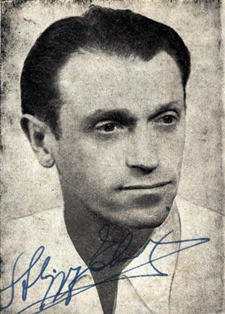Alojzy EHRLICH
(Source of the photo: French Table Tennis Federation. Our thanks.)
Translated from the biography established by the AFMD (Friends of the Foundation for the Memory of Deportation from the Allier Department)
Alojzy (Alex) Ehrlich was born on January 1, 1914 in Komańcza, Poland in the Carpathian Triangle. He was the only son of Izraël Ehrlich, of Jewish ancestry, and Blima née BRAND, who was Catholic. He was both circumcised and baptized. His family then settled in Lvov, where he discovered table tennis, which he would love throughout his life.
In 1933 his father sent him off to university at the Catholic Faculty of Lille.
An international league tennis table player, he was three times world singles vice-champion in 1936, 1937, and 1939.
In 1940 he joined the 3rd artillery division of the Polish army in France.
He was assigned to the 861st Group of Foreign Workers (GTE) in Bourbon-l’Archambault (Allier department) as a lumberjack.
Around 8:00 p.m. on June 18, 1944 the Militia arrived in Bourbon-l’Archambault and arrested the Quillier family, as well as Louis PEROZ and the policeman Jean DURAND, and took them to the Hôtel des Sources to be interrogated. Alex EHRLICH was there having a drink with Pierre WILDENSTEIN. The only crime of which these two men were guilty was being Jewish, and so they, too, were arrested.
The Militia called in the Germans, who transferred these five men to the Mal-Coiffée German military prison in Moulins (Allier department).
They suffered dissimilar fates: Jean DURAND, Louis PEROZ, and Emile QUILLIER, arrested as a measure of repression, were sent to the concentration camp at Buchenwald. Alex EHRLICH and Pierre WILDENSTEIN, arrested as a measure of persecution, were sent to Drancy, and then to the extermination camp at Auschwitz.
On July 15, Alex was transferred to Drancy and attributed the I.D. n° 25138.
(Source of the document below: Contemporary Jewish Documentation Center)
On July 31, 1944 he was deported from Drancy to Auschwitz in convoy n° 77.
In Le Mémorial de la Déportation des Juifs de France, Serge Klarsfeld writes about convoy n° 77: “The number of deportees was 1300. This convoy 77 (…) hauled toward the Auschwitz gas chambers more than 300 children under the age of 18. (…) 291 men were selected with I.D. numbers B 3673 to B 3963; the same for 283 women (A 16457 to A 16739). In 1945 there were 209 survivors, of whom 141 were women”.
He was selected for work duty with the I.D. n° B-3742.
As the Soviet troops advanced he was evacuated from Auschwitz, arriving at Dachau on January 28, 1945.
(Source: Memorial Annual of the French at Dachau)
There he was given I.D. n° 139264 and was liberated on April 29, 1945. He was admitted to the American Hospital on May 18, 1945 and repatriated on June 3, 1945 via Annemasse (Haute-Savoie department). He returned to Bourbon-l’Archambault in very bad physical shape. He spent two weeks in the Moulins Hospital, then went to Paris around the 14th of July, 1945 to the Hôtel Lutétia, the reception and supervision center for deportees.
(Source for the documents below: Copyright AFMD 75)
He remained in France and continued to practice the sport to which he remained devoted all his life. He became a table tennis coach.
He married Lieselotte Inge, née KÜHL.
Until his death he ran a shop of table tennis accessories in the Paris area.
He died on December 7, 1992 of “a long illness” in the Saint-Denis Hospital (Seine-St-Denis department) in the Paris suburbs.
(Source of the document below: French Table Tennis Federation)
We leave the conclusion to Dean DEVYS, the author of an excellent biography of Alex EHRLICH in 2 parts in the FTT magazine issues of February 2011 and April 2011:
“Had he had the luck to be born Hungarian or English, had there not been the tragic hiatus of the Second World War, he would certainly have been world champion, probably more than once. If he had chosen to be naturalized right after the Liberation – and he fulfilled all the conditions at that time — it is a good bet that his name would today figure among the ranks of our French champions. But we cannot rewrite History…”.
Our special appreciation to the Fédération Française de Tennis de Table for its assistance.
Sources:
– Archives of the Auschwitz Museum Internet site
– Contemporary Jewish Documentation Center
– Devys, Jean : biography of Alex EHRLICH in two parts, in the magazine of the FTT of February 2011 and April 2011, provided by Fédération Française de Tennis de Table
– Section of the Archives of the Victims of Contemporary Conflicts
– Public Records Office of Saint-Denis (Seine-Saint-Denis department)
– Fallut, Robert: Faits divers 1939-1945 dans le canton de Bourbon-l’Archambault Imprimerie Guériaud 2003
– Klarsfeld, Serge Memorial of the Jews Deported from France : 1942-1944 1978
– Memorial directory of the French at Dachau Amicale des Anciens de Dachau 1987


 Français
Français Polski
Polski










Poznałem pana Erlicha w Warszawie w 1969r przebywał na zaproszenie p.Józefa Prutkowskiego przyjaciela z lwowskiej HASMONEI.bYŁ TO PRZESYMPATYCZNY człowiek.
J’ai rencontré M. Erlich à Varsovie en 1969. Il était venu à l’invitation de M. Józef Prutkowski, un ami de HASMONEI à Lviv. C’ÉTAIT UN HOMME TRES SYMPATHIQUE.
remarkeble man. unfortunaly i only met him when i was only young and Did not realized his history
Thanks you for this.
Is it known if he had any children?